U.S. Recruits Japan As Global Military Partner
Politics / GeoPolitics Jan 13, 2011 - 09:30 AM GMTBy: Rick_Rozoff
 During the preceding week the U.S.’s top military officer identified Asia as the central focus of the Pentagon’s attention in the world, U.S. warships joined Japanese counterparts in military maneuvers in the East China Sea for the second time in a month, and Defense Secretary Robert Gates arrived in East Asia on a trip that began in China and will end in Japan and South Korea on January 14.
During the preceding week the U.S.’s top military officer identified Asia as the central focus of the Pentagon’s attention in the world, U.S. warships joined Japanese counterparts in military maneuvers in the East China Sea for the second time in a month, and Defense Secretary Robert Gates arrived in East Asia on a trip that began in China and will end in Japan and South Korea on January 14.
Secretary of State Hillary Clinton met with Japanese Foreign Minister Seiji Maehara at the State Department on January 6 after summoning him and South Korean Foreign Minister Kim Sung-hwan to Foggy Bottom a month earlier and holding a joint press conference with Maehara in Hawaii in late October. Following the last-named event, Clinton toured the Joint Base Pearl Harbor-Hickam and met with Admiral Robert Willard, head of U.S. Pacific Command, before embarking on a trip to the Asia-Pacific region that took her to Vietnam, China, Cambodia, Malaysia, Papua New Guinea, New Zealand and Australia from October 27 to November 8. In the last two countries she renewed, strengthened and expanded military ties with her hosts. [1]
Clinton’s meetings with her Japanese and South Korean opposite numbers, dealing in large part as they did with the conflict on the Korean Peninsula, intentionally – indeed brazenly – circumvented the six-party talks format which also includes North Korea, China and Russia. On October 27 she assured the Japanese foreign minister the U.S. viewed the Chinese-Japanese dispute over the Senkaku/Diaoyu island chain as covered by the Article 5 military assistance clause of the 1960 U.S.-Japan Treaty of Mutual Cooperation and Security, and five days later her spokesman Philip Crowley referred to Russia’s South Kuril Islands as the Northern Territories, the term used by Japan, which lays claims to them. [2]
During the recent Clinton-Maehara meeting, the participants “agreed to boost security cooperation” and announced that “the goals for cooperation will be revealed during Japanese Prime Minister Naoto Kan’s visit to the U.S. in spring.” [3]
Chairman of the Joint Chiefs of Staff Admiral Michael Mullen visited the capitals of South Korea and Japan on December 8 and 9 where he campaigned for both a tighter and deeper trilateral military partnership with his hosts and the forging of a Japanese-South Korean defense alliance. He advocated that South Korea and Japan accelerate that cooperation without being “hung up on what’s happened in the past,” a reference to the hundredth anniversary of Japan’s post-invasion annexation of Korea in 1910. He also “proposed joint military drills among South Korea, Japan and the U.S….” [4]
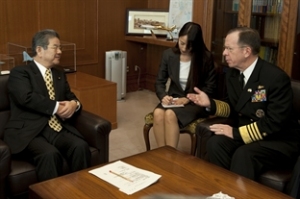
Chairman of the Joint Chiefs of Staff Mullen meeting with Japanese Defense Minister Toshimi Kitazawa in Tokyo on December 9, 2010
At the beginning of this month the Japanese foreign minister affirmed his nation’s commitment to forming the first military links between Japan and South Korea, stating: “We hope to conclude an alliance with South Korea to ensure security.” [5]
At the same time an official at the South Korean Defense Ministry confirmed Maehara’s assertion in revealing that Seoul and Tokyo intend to sign a defense agreement. “The pact, if signed, will open a new chapter in the development of military relations between South Korea and Japan,” he stated.
The South Korean news source from which the above is extracted added that “the U.S. has been urging the two neighbors to build a stronger military relationship.” [6]
On January 10 the defense ministers of Japan and South Korea, Toshimi Kitazawa and Kim Kwan-jin, met in the South Korean capital to plan “future-oriented” joint military relations and to “start discussing two pacts designed to facilitate their ties.” [7]
The defense chiefs signed a General Security of Military Information Agreement and an Acquisition and Cross-Servicing Agreement, the first providing for the pooling of intelligence and the second for exchanging military supplies for so-called peacekeeping missions – which is how Japanese and South Korean troop deployments to Iraq after 2003 and military assistance for the war in Afghanistan (troops from South Korea and ships from Japan) have been characterized – and military exercises.
The efforts of Admiral Mullen, Secretary of State Clinton and Secretary of Defense Gates have borne fruit.
The U.S. has led almost monthly naval war games in East Asia since late last July, when Mullen, Clinton and Gates visited South Korea for the sixtieth anniversary of the beginning of the Korean War, with the last two traveling to the Demilitarized Zone separating the two Koreas.
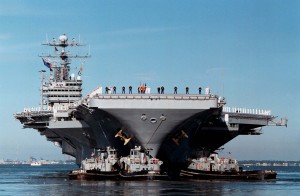
USS George Washington
The USS George Washington nuclear-powered supercarrier and its assigned carrier and expeditionary strike groups have participated in exercises in the Sea of Japan (East Sea), South China Sea, Yellow Sea and East Sea in that interim.
The Yellow Sea is bordered on the north and west by China, which maintains a 300-mile exclusive economic zone off its coasts there, and the Sea of Japan is abutted by the Russian port city of Vladivostok and reaches to oil-rich Sakhalin island, the southern part of which Japan owned until the end of the Second World War.
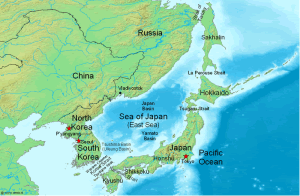
Last month the U.S. and Japan conducted the latest Keen Sword naval exercise in the East China Sea, which encompasses the disputed Senkaku/Diaoyu islands. It was the largest U.S.-Japanese joint military operation ever held, with 44,000 troops, 400 aircraft and over 60 ships, including USS George Washington. It also (deliberately) corresponded with the half-century anniversary of the U.S.-Japan mutual defense treaty.
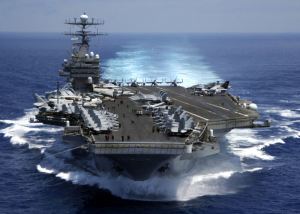
USS Carl Vinson
On January 10 the two nations reprised the drills on a more modest scale, with the nuclear-powered aircraft carrier USS Carl Vinson and the destroyers USS Gridley and USS Stockdale joining the Japanese destroyer JS Kurama and helicopters from both nations in naval maneuvers in the East China Sea. The three American warships, joined by the guided missile cruiser USS Bunker Hill, then headed for South Korea. Vinson and Bunker Hill visited Busan, where last October the guided missile destroyer USS Lassen participated in the first Proliferation Security Initiative [8] exercise hosted by South Korea. In all ten warships and fourteen nations – including Australia, Canada, France and Italy – participated in what was codenamed Eastern Endeavour 2010.
Since the sinking of the Korean corvette Cheonan last March and President Obama’s upbraiding of Chinese President Hu Jintao over the incident three months later [9], the official rationale for regular U.S. war games in East Asia have been the actions of North Korea.
But the deployment of an Aegis class warship capable of launching Standard Missile-3 anti-ballistic missiles – USS Lassen – off the coast of South Korea in a drill nominally aimed at monitoring the “trafficking of weapons of mass destruction” and the dispatching of one of the U.S.’s eleven nuclear supercarriers to the East and South China Seas have nothing to do with putative threats from Pyongyang.
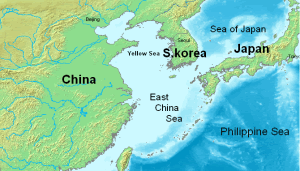
Confirmation of that fact recently appeared in an unlikely location. The official armed forces publication Stars and Stripes ran a feature on January 11 entitled “China real reason for South Korea, Japan military pact?”
Referring to the preliminary military agreements reached by Japan and South Korea the day before, the newspaper stated that “The top two U.S. allies in Asia are inching toward greater military cooperation,” in “an incremental but important development in Asian defense cooperation with an eye toward China.”
It quoted Denny Roy of the East-West Center, a think tank established by the U.S. Congress in 1960, as asserting: “South Korea-Japan (military) cooperation has more implications for China than the Korean peninsula. North Korea provides the political excuse for what would otherwise be a strategic move” against China. “It’s a fig leaf.”
The Stars and Stripes article added: “Should conflict erupt on the Korean peninsula, Japan would likely play a crucial role in U.S. and South Korean combat efforts, experts said.
“South Korea and Japan sent observers to participate in each other’s military exercises with the U.S. last year, a development viewed as an important step toward deeper military cooperation.” [10]
Japan deployed military observers to the U.S.-South Korea Invincible Spirit war games in the Sea of Japan in July and South Korea returned the favor during the Keen Sword 2011 exercise in the East China Sea in December.
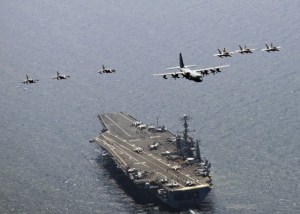
Invincible Spirit
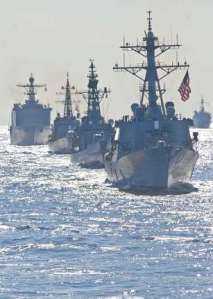
Keen Sword 2011
The South Korean newspaper Hankyoreh also reflected on the groundbreaking Japanese-South Korean military agreements signed on January 10, warning:
“A military pact between South Korea and Japan is problematic first and foremost because it legitimizes Japanese military expansion. Tokyo has been striving for some time to broaden the range of activity for the JSDF [Japan Self-Defense Forces]. In 1999, it enacted the Surrounding Situation Act, and has recently been mulling over an amendment of the law in connection with collective self-defense rights. The attempt to form a military pact with South Korea is part of this current. For example, the proposed agreement on munitions support would allow the two countries’ armed forces to loan out food, water, and fuel during times of emergency. Naturally, this would bolster the expansion of the range of JSDF activity.
“Moreover, Japan has recently been inquiring about dispatching forces to the Korean Peninsula in a time of emergency. Some time ago, Prime Minister Naoto Kan raised the possibility of the JSDF operating in North Korea and South Korea, on the pretext of rescuing Japanese refugees and abduction victims. At this point, our country should have grilled Japan on its true intentions at yesterday’s talks and strongly demanded that the misguided notion be withdrawn.
“There are also major concerns that military cooperation between South Korea and Japan will further develop the New Cold War structure taking shape in Northeast Asia. To date, the United States has been in the middle urging stronger military cooperation between Seoul and Tokyo, and Japan has actively welcomed this. The reason for this is that the strategic interests of those two countries coincide in their intent to curb Beijing.”
The paper’s editorial also penetratingly remarked on the consequences of the U.S.-Japan-South Korea military axis arrogantly excluding the other three members of the six-party format:
“It is not at all a desirable outcome for [South Korea] if military cooperation with the United States and Japan leads to stronger military cooperation among North Korea, China, and Russia and the Korean Peninsula becomes a stage for confrontation between these two sets of forces.” [11]
Confrontation – armed conflict and in the worst case war – is precisely what is being prepared for and which may be precipitated by Washington’s consolidation of the tripartite military alliance.
The National Defense Program Guidelines for 2011 adopted by the Japanese Ministry of Defense last month identified its major regional concerns as follows:
“North Korea’s nuclear and missile issues are immediate and grave destabilizing factors to the regional security.
“Military modernization by China and its insufficient transparency are of concern for the regional and global community.
“Russia’s military activities are increasingly robust.” [12]
According to the Japanese press, Tokyo’s new military strategy has shifted to “a posture that can effectively deal with possible contingencies on Japan’s vulnerable southern islands and China’s growing military presence.” [13]
An appendix to the guidelines details plans to increase the nation’s submarines from 16 to 22, acquire next-generation fighter jets and add to the number of Aegis class destroyers equipped with Standard Missile-3 interceptor missiles from the present four. [14] (South Korea has recently awarded a contract to Lockheed Martin to outfit another of its warships with Aegis missile defense technology. The third such destroyer is to be sea-ready next month.)
Japan will then equip all its six Aegis destroyers with Standard Missile-3 interceptors, and “Patriot Advanced Capability-3 interceptor missiles will be deployed at air bases nationwide,” [15] including those at Aibano, Ashiya, Gifu, Hakusan, Hamamatsu, Iruma, Kasuga, Kasumigaura, Narashino, Takaradai, Takeyama and Tsuiki.
The U.S. already maintains a Patriot battery at the Kadena Air Base on Okinawa.
In the meeting between Secretary Clinton and Foreign Minister Maehara earlier this month, the two sides “agreed to establish new common strategic goals for the Asia-Pacific region and other parts of the world.”
They also concurred that “the six-party talks on North Korea’s denuclearization and bilateral talks between Washington and Pyongyang can resume only if the North stops its provocative actions and takes concrete steps to abandon its nuclear program,” a rude rebuff to Chinese and Russian efforts to resume the talks without preconditions. China and Russia share borders with North Korea and can ill afford the consequences resulting from the further destabilization of the peninsula.
Clinton said that U.S.-Japanese collaboration should include the “full range of global and strategic issues, from nuclear proliferation to maritime security.” [16]
Japan will soon send a delegation of military officials to the U.S. to inspect Global Hawk unmanned aerial vehicles for acquisition “at a time of heightened tensions with neighbouring China and North Korea.”
“The defense ministry will start fully fledged research in the next fiscal year starting April, and intends to make a final decision on whether to deploy such aircraft by the end of fiscal 2015.” [17]
Global Hawks fly at an altitude of 60,000 feet, can survey up to 40,000 square miles of territory a day, and cost $35 million apiece.
The day Clinton met with the country’s foreign minister, it was reported that Japan will “move the command post for its missile defense system from a Self-Defense Force facility to a US airbase this year.”
Japan’s Defense Ministry said that “the plan will see the Air Self-Defense Force Command in Fuchu, Tokyo move into the compound of the US Yokota airbase in the same city.
“The shift will begin in March and is expected to be complete within the year. [T]he move will help the Self-Defense Force improve its speed of detection and response to incoming missiles identified by US early-warning satellites….” [18]
On January 10 the Japanese press disclosed that the “government will approve the transfer by the United States of next-generation antimissile missiles currently under joint Japan-U.S. development to third-party countries,” in the most fragrant violation yet of the constitutional prohibition against so-called collective self-defense.
The initiative will permit “the United States to have…SM-3 [Standard Missile-3] Block IIA missiles deployed in Europe and other parts of the world” and is “aimed at showing Japan’s resolve to deepen its alliance with the United States, several government sources have revealed.
“The Obama administration has been seeking Japan’s accord on deployment of the next-generation missiles, which are being developed primarily to beef up Japanese, U.S. and European missile defense networks.” [19]
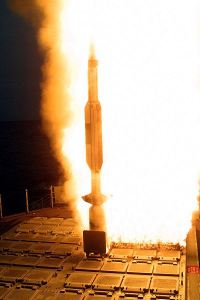
Standard Missile-3 launch
What Japan and the U.S. are collaborating on is the deployment of dozens of SM-3 missiles adapted for land-based deployments (as part of what the U.S. calls the Aegis Ashore program) in Romania, Poland and other nations on and near Russia’s western borders.
At the North Atlantic Treaty Organization summit in Lisbon, Portugal in November, the 28-member military bloc endorsed U.S. plans to place the European continent under an American-dominated interceptor missile shield.
The SM-3 is the interceptor missile heart of the Aegis Ballistic Missile Defense System developed by the Pentagon, which has as its only partner to date the Japan Maritime Self-Defense Force.
In 2007, 2008 and again in October of last year Japanese Aegis class warships launched SM-3s in tests run from the U.S. Navy’s Pacific Missile Range Facility on Kauai, Hawaii. In the most recent test, the recently upgraded JDS Kirishima guided missile destroyer fired an SM-3 100 miles over the Pacific to destroy a ballistic missile target, a “significant milestone in the growing cooperation between Japan and the U.S. in the area of missile defense.” [20]
Tokyo’s new National Defense Program Guidelines mandate equipping all six of its Aegis class warships with SM-3s as observed earlier.
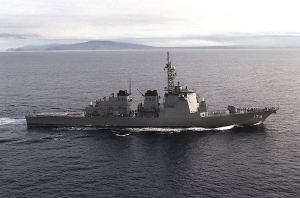
JDS Kirishima Aegis class destroyer
In addition to rendering the U.S. services for the wars in Afghanistan and Iraq, Japan is also planning to become the first non-NATO nation to join the Pentagon in the Horn of Africa nation of Djibouti by opening its first overseas military base since World War Two. [21]
Japan’s military partnership with the U.S. will include joint endeavors in three continents – Asia, Europe and Africa – and the Middle East and the Arabian Sea.
On January 5 one of the main architects of heightened U.S.-Japan and U.S.-Japan-South Korea strategic military integration, Admiral Michael Mullen, released his Joint Chiefs of Staff’s guidance for 2011, “relaying the admiral’s priorities and strategic objectives for the year.” [22]
The document addresses Pentagon plans for the world and these component policies:
-”We will contribute to stability and defend our vital national interests in the broader Middle East and South Central Asia.
-”Over the last year, the balance of our resources and effort shifted from the war in Iraq to the one in Afghanistan.
“We must continue to transition well in Iraq and lay the foundation for a long-term partnership between our two countries.
“This transition in Iraq has allowed us to alter our posture and focus in the Gulf and in the Levant.”
-”The most significant threat to regional stability remains an Iranian regime that seeks the development of nuclear weapons, even as it continues to support terrorist organizations and acts throughout the broader Middle East.
“Accordingly, and in keeping with the President’s National Security Strategy, we will reassure our partners and allies through our efforts to build their defense capabilities and capacity.
“We will continue to plan for a broad range of military options should the President decide to use force to prevent Iran from acquiring nuclear arms. Pursuant to that, we will maintain – as we have maintained – a robust force presence in the Gulf region.”
-”We face additional challenges and opportunities elsewhere around the globe. We must continue to support local efforts to combat the extremist threat that emanates from places like Somalia, Yemen and North Africa.”
-”In Europe, we will…implement a new NATO Strategic Concept by placing increased emphasis on cyber security, ballistic missile defense, and nonproliferation.”
And, most saliently:
“In the response to an aggressive North Korea and a more assertive China, our efforts to balance risk have increasingly focused on Asia.
“We will be prepared to support and defend our freedom of navigation and access to the global commons. Our partners and allies are our greatest strategic asset in the region. We will work with them to conduct multilateral exercises and operations….” [23]
At the forefront of the Pentagon’s strategic assets in the Asia-Pacific area and increasingly far beyond is Japan.
Notes
1) Obama, Gates And Clinton In Asia: U.S. Expands Military Build-Up In The East Stop NATO, November 7, 2010
http://rickrozoff.wordpress.com/2010/11/07/obama-gates-and-clinton-in-asia-u-s-expands-military-build-up-in-the-east
2) U.S. Supports Japan, Confronts China And Russia Over Island Disputes Stop NATO, November 4, 2010
http://rickrozoff.wordpress.com/2010/11/04/u-s-supports-japan-confronts-china-and-russia-over-island-disputes
3) Russian Information Agency Novosti, January 7, 2011
4) Yonhap News, January 4, 2011
5) Russian Information Agency Novosti, January 3, 2011
6) Yonhap News, January 4, 2011
7) Xinhua News Agency, January 10, 2011
8) Proliferation Security Initiative And U.S. 1,000-Ship Navy: Control
Of World’s Oceans, Prelude To War Stop NATO, January 29, 2009
http://rickrozoff.wordpress.com/2009/08/26/proliferation-security-initiative-and-us-1000-ship-navy-control-of-worlds-oceans-prelude-to-war
9) U.S. Risks Military Clash With China In Yellow Sea Stop NATO, July 16, 2010
http://rickrozoff.wordpress.com/2010/07/16/u-s-risks-military-clash-with-china-in-yellow-sea
10) Stars and Stripes, January 11, 2011
11) Hankyoreh, January 11, 2011
12) Summary of National Defense Program Guidelines (NDPG), FY 2011
http://www.uk.emb-japan.go.jp/en/news/NDPG.pdf.
13) Asahi Shimbun December 11, 2011
14) U.S. Builds Military Alliance With Japan, South Korea For War In The East Stop NATO, December 14, 2010
http://rickrozoff.wordpress.com/2010/12/14/u-s-builds-military-alliance-with-japan-south-korea-for-war-in-the-east
15) Kyodo News, December 11, 2010
16) Japan Times, January 11, 2011
17) Radio Netherlands/Yomiuri Shimbun, December 30, 2010
18) Japan Broadcasting Corporation Monitored by Kuwait News Agency January 6, 2011
19) Yomiuri Shimbun, January 10, 2011
20) Global Security Newswire, October 30, 2010
21) Japanese Military Joins U.S. And NATO In Horn Of Africa
Stop NATO, April 25, 2010
http://rickrozoff.wordpress.com/2010/04/26/japanese-military-joins-u-s-and-nato-in-horn-of-africa
22) Department of Defense, January 5, 2011
23) GJCS Guidance for 2011 http://www.jcs.mil//content/files/2011-01/011011165132_CJCS_Annual_Guidance_2011.pdf
Stop NATO |
|
Global Research Articles by Rick Rozoff |
|
© Copyright Rick Rozoff , Global Research, 2011
Disclaimer: The views expressed in this article are the sole responsibility of the author and do not necessarily reflect those of the Centre for Research on Globalization. The contents of this article are of sole responsibility of the author(s). The Centre for Research on Globalization will not be responsible or liable for any inaccurate or incorrect statements contained in this article.
© 2005-2022 http://www.MarketOracle.co.uk - The Market Oracle is a FREE Daily Financial Markets Analysis & Forecasting online publication.



